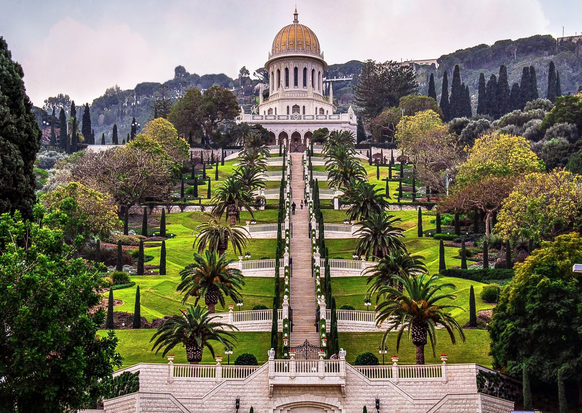Haifa Attractions
Haifa offers a wide range of attractions, many of them within walking distance of the two Dan hotels on the cusp of Mount Carmel. We made a list of some of the leading attractions in the city which has become the perfect destination for a family vacation. The popular tourist sites on the Carmel, the museums and galleries, urban tours in the lower city and the city’s wonderful beaches – if you’re looking for things to do in Haifa with the children, as a couple or on your own, this page is for you.
Local Attractions

HAIFA: THE CLASSIC URBAN TREK. Bahai Gardens, German Colony, Louis Promenade, Ofer Gardens
Let’s set out on the classic, popular and familiar trek through the city of Haifa. It takes us from the peaks of the Carmel Mountains to the German Colony. What can we look forward to? Breathtaking landscape, history, art, religions, architecture and preservation works.
Right here below the hotel you'll find the gorgeous Louis Promenade, 400 meters that stretch across the mountain range above Yefeh Nof Street and offer panoramic vistas of Haifa, from the city to the bay, to the Krayot, Acco and Rosh Hanikra, the Galilee Mountains, and on a clear day, as far as Mount Hermon. From here you can also see the hanging Bahai Gardens which have earned a UNESCO World Heritage Site designation. The gardens link to the German Colony’s main road which then heads towards the port and the sea. These iconic vistas become the city of Haifa’s internationally recognized “identity card.”
The promenade, built in 1992, is considered one of Israel’s most beautiful. We’ll connect to it via a small lane that passes between the Tikotin Museum of Japanese Art and the Dan Carmel Hotel’s entrance plaza. The path passes right under the hotel’s renowned Rondo Restaurant. The end of the promenade brings us to a small grove planted by the Templers, and known as “Emperor’s Grove.” Here the Templers positioned a stone obelisk on which the names of Emperor Wilhelm II and his wife Augusta Victoria are engraved, commemorating their visit to the colony at the start of their journey in the Land of Israel in 1898. Next to the obelisk is a Belgian maritime cannon from the mid-19th century, in use on French and Turkish warships. We recommend a short walk through the gardens adjacent to the promenade. Commonly known as “the fawn garden” for the sculpture of the fawn drinking from a pond, and additionally known as “Yefeh Nof” Garden, the pond and waterfall were planned by the architect Shmuel Rozov, who also planned the Dan Carmel Hotel. The fawn was produced by sculptor Arieh Resnik.
Let’s continue to the next location, the Sculpture Garden, which is some 10 minutes’ walk away. We leave the promenade for Yefeh Nof Street and walk west. Down the street’s slope we connect with Hanassi Boulevard where we turn right. A short walk brings us to Hatzionut Avenue, where we cross the road and continue down Hatzionut Ave. Next to house number 110 we find the entrance to the Ursula Malbin Sculpture Garden. It is one of the most enchanting and special spots in Haifa, a green oasis that leaves the bustling street far behind, and overlooks the blue bay. Scattered across the garden are 29 delicate bronze sculptures donated by sculptor.
Now let’s go back to Hatzionut Avenue and continue to our next stop, the Bahai Gardens. Entrance is free. Enter from 80 Hatzionut Avenue, the main entrance, which leads you straight to the main Bahai Garden area, the shrine, and the surrounding gardens which UNESCO, in 2008, declared a World Heritage Site. The Gardens are a system of 19 terraces built in stages across some four decades, between the 1950s to the 1990s. The shrine preserves the remains of the Bahai Prophet, known as the Bab, who first spread the concept of the Bahai faith in the mid-19th century in Persia. The Bab’s heir, known as Baha-Ullah and viewed as the faith’s founder, is buried in Acco but the Haifa gardens, which constitute the Bahai World Center, have become the holiest site to the Bahai adherents. Baha-Ullah’s son, Abas Effendi, known as Abdul-Baha, carried the community’s management and leadership until his death in Haifa in 1921, following which he was buried alongside the Bab in another room of the shrine on the Carmel Mountain.
Currently the Bahai community worldwide is run by a commission of 9 persons who operate from a holy temple complex built on the mountain adjacent to the shrine and other structures.
Entering the shrine requires modest dress and bare feet. Photography inside the shrine is prohibited. Eating, smoking and chewing gum are prohibited everywhere in the gardens but bottles of water can be brought in.
Insert image
Independent visits: We recommend checking the Bahai website for visit times: https://www.ganbahai.org.il/self-guided-visits The Bahai Gardens are closed on Bahai holy days and Yom Kippur.
Our visit to the Bahai Gardens over, we’re now ready to continue on to the German Colony. Leaving the gardens, turn left and head down Hatzionut Avenue, then left again into Shifra Street. Here we integrate into the Haifa stairs which drop down the Carmel Mountain’s side to the Lower City. At the end of Shifra Street we go down the Shifra Steps into Abbas Street, turn left, then continue to go down the Kramim Steps into Geffen Street. There we turn left and reach UNESCO Square. Facing us is Sderot Ben Gurion which goes all the way to the sea. This is the German Colony’s main road. The German Colony in Haifa was built by the Templers, members of a Christian Protestant pietist sect founded in Wurttemberg, Germany. According to their belief, bringing the redemption about an only occur by living and working hard in the Holy Land. They sought to uphold an idealistic lifestyle by establishing productive villages in the Land of Israel.
The best way to start a tour of the German Colony is to head for the Haifa Tourist Association branch at 48 Rothschild Boulevard. A city of Haifa Information Center operates there, where you'll be able to get more detailed information and a map of the colony. In recent years the German Colony underwent renovations and preservation activities that made it one of the liveliest and unique entertainment and leisure spots in Haifa.
Using street signage you'll be able to enjoy the heritage preservation efforts on dozens of Templer homes along the boulevard, including the Oliphant House, Schumacher House, the Templer Community House, and more.
Go for a stroll through the Colony and learn about the Templers’ long history in Israel, take a peek into the gardens and courtyards, enjoy the atmosphere of the preserved buildings, and stop for a coffee or bite to eat from the many choices available.
Our urban trek has almost come to an end. We recommended planning it so that you have enough time to also take in the Haifa City Museum, opened in 2000 in the Beit Ha'am [Community Center] buildings and the Templer School buildings at 11 Sderot Ben Gurion. Documenting the city’s history, it is open: Sunday 10 am - 4 pm, Wednesday 10 am - 4 pm, Thursday 12 midday - 8 pm, Friday 10 am - 2 pm, and Saturday 10 am - 4 pm.


